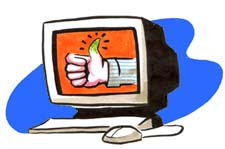When Clifford Sharples and two partners created Garden.com
Gardening, notes Sharples, the company’s president and CEO, is a $47 billion market, but it is dominated by small local businesses. No company has had more than a 1% market share. Direct mail distribution has been proven, with more than 10% of products shipped directly to customers. Two of three U.S. households participate in gardening, and the demographics of gardeners closely parallel online profiles.
The idea underlying Garden.com was to create a powerful brand and offer one-stop shopping for gardening information, products and services, leveraging information technology and the internet to create a new value proposition. "We looked at where we could apply information directly at the point of sale," Sharples said. "We wanted an industry where there were not a lot of brands." The goal was to become the Starbucks of the gardening business, creating the first "category killer" retailer in the industry.
Sharing his strategy during a recent board meeting of Wharton’s SEI Center for Advanced Studies in Management that dealt with "The Challenge of Leadership in the Global Information Age," Sharples said that Garden.com offers 20,000 SKUs (Stock Keeping Units), yet it doesn’t hold them in inventory. The "bricks and mortar" of the site are the content and services for the customer. Internet technology allows businesses such as Garden.com to build the customer relationships of a local hardware store with the economies of scale of a large retailer. For example, customers can get customized advice based on their local growing conditions and personal preferences. The company has also assembled gardening experts to respond to questions and offers a growing database of frequently asked questions to provide instant responses to online queries. "We created the biggest online horticultural database the world has ever seen," Sharples said.
The most popular way to buy plants is "Plant Finder." It makes recommendations based on the customer’s zip code and other preferences. For example, a customer might want plants that will do well in a yard that has lots of shade or plants that are resistant to deer. Recommendations based on past purchases tend to be much trickier because a customer might buy a specific plant for many reasons, including its color, smell, growing properties, etc. The company is also uses information to create customized promotions for individual customers. "One of the challenges is that the data warehouse gets big very fast, and getting a data warehouse into production on the fly is very hard," Sharples said.
Distribution was a major challenge for Garden.com. Unlike books or CDs, which can sit in a warehouse, plants often need to go relatively quickly from the field to the customer. Where Amazon.com could plug into existing book distribution channels, there were no national distribution channels for gardening, so Garden.com had to set them up. The company used information technology to create a "virtual warehouse" system that could satisfy a very demanding base of customers (who also buy from retailers such as L.L. Bean). Garden.com established an information network, called "trellis," that sends customer orders out to suppliers and allows the company to track fulfillment and delivery without having to put its hands into the soil.
After meeting the challenges of building the site and creating a distribution network, Sharples is now focused on building the brand. For example, the company has partnered with a publisher to create a gardening magazine that will offer advice to gardeners and be available on the newsstand.
After his presentation, Sharples fielded a wide range of questions from the audience, including:
Have you considered globalization?
The interest is there. The company has attracted members from more than 40 countries, but we cannot ship plants internationally. It is hard enough getting them from state to state. To build global markets, we will have to build new supply chains in different countries in the same way we have built distribution systems in the U.S.
What about price?
We chose gardening because it is not a commodity business. This is not a John Grisham novel that is the same everywhere. You want a certain plant of a certain variety. With 20,000 SKUs, we are the largest in the world, so our prices are not as high as the most expensive retailer but they are medium to high. For suppliers with their own catalogs, we price the same as the catalog.
How do you handle plants that are dead on arrival?
Our products have 110% guarantee. If the plant arrives dead on the doorstep, we either send you a new plant via Federal Express, return the money to your credit card or give you a 110% credit on the web site. We have a customer recovery team that focuses on winning customers back. Suppliers cover losses equal to the level they have in traditional direct mail business. To the extent that online customers differ from catalog customers, Garden.com covers the difference. (In most cases, we’ve tended to have lower return rates than mail order.)
How do you improve the quality of the whole experience of giving advice on the net?
From the standpoint of asking questions, we have Garden Doctor service. People ask: "My lilac plant looks sick. What can I do?" We have a team of garden doctors who answer questions in 24 to 48 hours. We now have 50,000 Q&As and we put them in a database on the web site so you can get answers in real time to many questions.
How do you manage the customer relationship?
We focus first on communications and customer acquisition. If they come to the web site, we try to get them to sign up as members. If they are members, we try to get them to purchase for the first time. If they have purchased, we try to get them to repeat. We have teams that cut across traditional work functions that address each of these issues. We are looking at ways to send customized e-mail with offers to people who looked at information on roses, put one in the wheelbarrow (the shopping cart) and didn’t buy it.
Is the company profitable?
We don’t talk about profits on the internet. We’ve grown 300% per year. By June of the past year, we had $5.4 million in annual revenue, but lost $16 million in the last fiscal year. Garden.com has $50 million invested, another $50 million in the IPO and a market cap of about $300 million.
How many eyeballs?
In the fourth quarter (June), the height of the season, we had 4 million people, with 1.7 million in our highest month.
What were the biggest challenges?
The challenge was building proprietary technology and getting it out there very fast. We started building it in January and went live on the web in March. The site started off very commerce-focused, but within a year, we added community and content.
The internet is expected to make it less expensive to do business. Has this been your experience?
We originally did not anticipate the level of investment we needed in customer service. Our service organization now has 60 people, but it is all a matter of scale and as you get scale the relative expenses fall.
What is your policy on the privacy of the names and information you gather?
We don’t share them. When you are paying $60-$70 per name in customer acquisition costs, that is a key asset and you don’t want to sell it.



